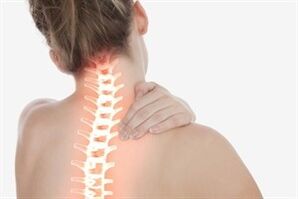
Cervical osteochondrosis is a dystrophic dysfunction of the intervertebral discs in the cervical spine. The disease manifests itself in the form of severe pain in the head, neck and upper back.
The danger of osteochondrosis lies not only in the deterioration of the quality of life, but also in the threat of disability.
Characteristics of the SOC course in women
The symptoms of the development of diseases of the spine in men and women are practically the same, but there are still some differences. Cervical osteochondrosis is diagnosed more often in women. This is due to anatomical peculiarities.
Unlike women, men have well-developed shoulder girdle muscles that support the cervical spine.
Relation.The condition of the spine is negatively influenced by pregnancy and the further care of the child.
The reason for the development of female cervical osteochondrosis may be hormonal changes that occur during the aging process. After the menopause, the metabolic and nutritional processes in the cartilage tissue slow down.
causes and factors
There are many reasons for the development of SOS in women. The most common are menopausal changes in the body. During this period, the amount of progesterone in the female body decreases significantly. As a result of these processes, the support of the spine becomes weaker.Other reasons include the following factors:
- circulatory problems;
- passive lifestyle;
- the presence of excess weight;
- great physical activity;
- weak immunity;
- heredity;
- spinal injury;
- hormonal problems;
- hypothermia.
The list of provoking factors is quite extensive. Women need to pay special attention to monitoring their health and supporting the immune system.
symptoms
How the disease manifests itself at an early stage
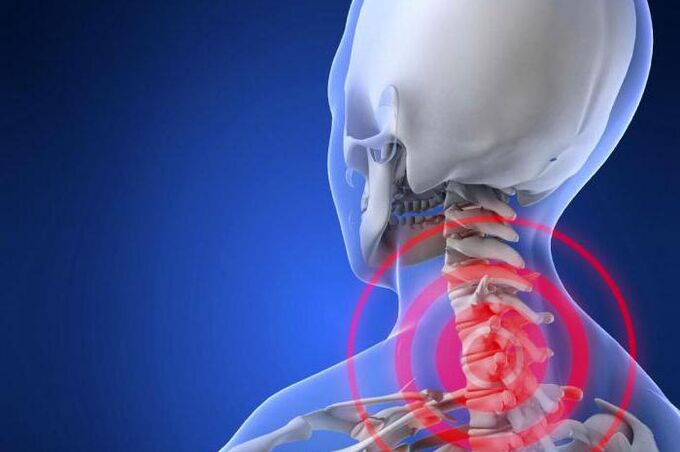
It is important to recognize the signs of the development of the disease in time.Early symptoms include:
- feeling of stiffness in the neck;
- sudden snoring while sleeping;
- regular headaches;
- discomfort in fingers and shoulder;
- periodic numbness of the limbs;
- stabbing pains radiating to the back of the neck.
local characters
With cervical osteochondrosis, a number of local symptoms appear.These include the following manifestations:
- stenosis;
- reflex irritation syndrome;
- radicular syndrome;
- cardiac syndrome.
Stenosis involves a violation of blood circulation in the affected area. The patient feels stiffness and pain. There may be numbness and tingling in the extremities.
The reflex irritation syndrome can manifest itself in the form of a burning tingling sensation.The pain can radiate to the shoulder joint or chest.
Radicular syndrome causes headaches. Sometimes there are problems with the language.
Heart syndrome is inherently similar to an attack of angina pectoris. In some cases, blood pressure rises and arrhythmias appear.
Signs of an acute condition
During the acute stage, deformations of the vertebrae are observed, compressing the vertebral artery.Due to the fact that blood does not get to the brain, the following deviations are observed:
- speech disorder;
- Dizziness;
- ringing in the ears;
- double vision.
Pain can radiate to the stomach, heart, and lungs. When the nerve endings of the neck region are pinched, there is a pulling pain from the neck to the shoulder blades.
Stages of the disease and their specifics
SHOC proceeds in several stages. Each of them has its own characteristic symptoms.In total, there are 4 main stages in the development of osteochondrosis:
- In the early stages, the disease looks like a dehydration of the nucleus pulposus. The patient develops tears in the annulus fibrosus.
- The second stage involves flaccid muscles and ligaments. As a result, there is a motor imbalance in the vertebrae. This stage of the development of the disease is characterized by a displacement of the vertebrae.
- The third stage of development is characterized by more pronounced symptoms. Patients develop bulging discs and osteoarthritis.
- The fourth stage is the last. A special feature are osteophytes. Bony growths form on the surface of the vertebrae. There is an increase in fibrous tissue.
Without timely diagnosis and treatment, the disease can lead to disability.
diagnosis
When the first symptoms of the disease appear, you should consult a doctor to undergo an examination and prescribe appropriate treatment.In addition to collecting an anamnesis, the doctor prescribes a number of diagnostic studies.
Instrumental investigation methods
Instrumental diagnostic methods help to accurately diagnose and determine the patient's condition. The most commonly prescribed procedures are:
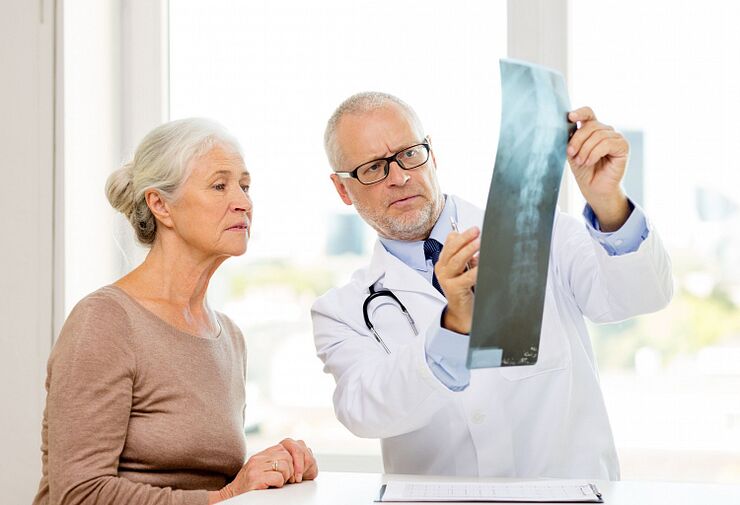
- Roentgen;
- myelographic study;
- Ultrasonic;
- MRI.
A simple x-ray is required to get a picture of the entire spine or its affected part.With its help, the doctor can determine the localization of the pathology. With osteochondrosis in the image of the spine, you can see the presence of bone growths and narrowing of the intervertebral disc.
A more complex type of diagnosis is a myelographic examination. It consists of injecting a contrast fluid into the canal of the spinal cord.
Important.Such a procedure can be dangerous, since an allergic reaction or damage to the spinal cord is possible.
Such a study allows you to examine the internal structure of the spinal canal.
CT and MRI are among the most effective diagnostic methods. According to their results, osteochondrosis can be distinguished from other diseases with similar symptoms.
treatment
Medical therapy
Treatment of cervical osteochondrosis should be comprehensive. Drug therapy is an important part.In most cases, the following groups of drugs are prescribed:
- analgesics;
- antiphlogistic;
- chondroprotectors;
- muscle relaxants;
- vitamins.
Analgesics include nonsteroidal drugs that relieve pain. Most of these drugs irritate the lining of the digestive tract.
To relieve the inflammatory process, hormonal drugs are prescribed.Effective steroid drugs include ointments and tablets based on glucocorticosteroids.
Chondroprotectors include in their composition substances that replace the components of cartilage tissue - hyaluronic acid and chondroitin. In order to achieve a lasting effect from taking such drugs, a fairly long therapeutic course is prescribed.
To relax muscle tone, it is recommended to take muscle relaxants.These are auxiliary medicines used to relieve pain. The muscle relaxant is administered parenterally and only under the supervision of a specialist. For the treatment of osteochondrosis, funds based on benzimidazole and glycerin are used. They have a large number of contraindications.
To maintain the functioning of the immune system, vitamin complexes are prescribed. They have a positive effect on the peripheral nervous system. The composition must contain fat-soluble vitamins E, D, C, E and B vitamins.
Very effective in the treatment of osteochondrosis ointments for external use.They help with inflammation, warm and relieve pain. Before using them, you should consult a specialist.
Are the medications effective?
Drug treatment of cervical osteochondrosis is very effective. It allows you to get rid of the inflammatory process and reduce pain. To achieve the maximum therapeutic effect, taking medication should be combined with therapeutic exercises and massage.
gymnastics
Before starting gymnastics, you should consult a specialist. With exacerbations, it is better to refuse physical activity. It is important that gymnastics does not cause an aggravation of pain.
Relation.All exercises are as simple as possible and involve head movements and isometric muscle tension.
Such gymnastics can be performed both at home and at work. The starting position for almost all exercises is a sitting position.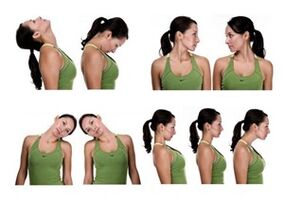 Approximate set of exercises:
Approximate set of exercises:
- Head turns all the way to the right, then to the left. It is important not to make strong jerks. When turning, the tension must be maintained for 5 seconds.
- Tilts head to shoulder. You must try to touch your shoulder with your ear, while you should not raise your hand yourself. Exercise should be performed at a painless amplitude.
- Circular movements of the head counterclockwise and clockwise. Rotations should be performed as slowly as possible.
Such a light load will help stretch the muscles. In order for it to bring good results, such gymnastics must be performed regularly. In this case, the increase in load should be gradual and painless.
massage
Massages should only be performed by a professional. It is necessary to train the neck area, part of the back and the collar zone.The following techniques can be used:
- stroke;
- to squeeze;
- trituration;
- knead.
The massage should not cause pain. A procedure performed by laypeople can only aggravate the situation.
Folk remedies at home
Alternative therapy methods can be used in addition.It can be compresses made from fresh horseradish leaves. They are applied to the cervical region and must be kept overnight.
Pretty effective compress made from grated potatoes and honey. This procedure should be done no more than 1 time per week. Folk remedies help to alleviate the patient's condition, but do not cure the disease.
Is it possible to cure SHX completely?
Cervical osteochondrosis cannot be completely cured.Therapy is aimed at improving the patient's condition and stopping the development of the disease. Regular relapses are possible, so the patient should carefully monitor her condition. The earlier the treatment is started, the better the result.
prevention
Right nutrition
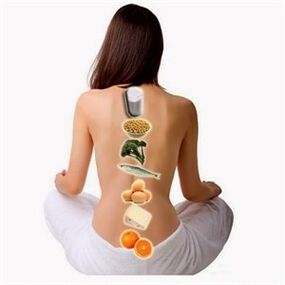
An important place in the prevention of cervical osteochondrosis is proper nutrition. The diet should include products containing synthesized substances for cartilage tissue. It can be jelly, jelly or gelatin.
Important.The body must have enough protein.
It is found in fish, eggplant and meat. It is important to monitor the water balance. Lack of water can lead to dehydration of the intervertebral discs.
The diet should contain foods rich in vitamins and minerals. For example fresh fruit, vegetables, seafood, pork and beef.
Active Lifestyle
An active lifestyle minimizes the risk of contracting the disease.Women are not recommended to lift more than 10 kg. If you have problems with your spine, it is advisable to wear a special corset.
In order to have a good and long sleep, it is best to buy a special orthopedic mattress and pillow. Experts recommend swimming, but it is better to refuse running and jumping. During the period of exacerbation, you can not visit the bath.
Cervical osteochondrosis is diagnosed more often in women.It is important to notice the first signs of a deviation in time and start treatment. The earlier therapy is started, the more effective it is.




























